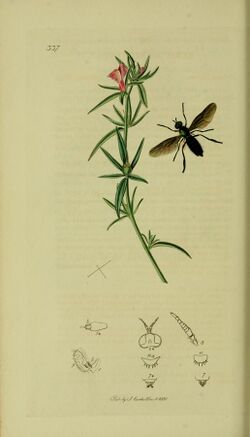Biology:Beris geniculata
| Beris geniculata | |
|---|---|

| |
| British Entomology illustration | |
| Scientific classification | |
| Domain: | Eukaryota |
| Kingdom: | Animalia |
| Phylum: | Arthropoda |
| Class: | Insecta |
| Order: | Diptera |
| Family: | Stratiomyidae |
| Subfamily: | Beridinae |
| Genus: | Beris |
| Species: | B. geniculata
|
| Binomial name | |
| Beris geniculata Curtis, 1830[1]
| |
| Synonyms | |
| |
Beris geniculata, the long-horned black legionnaire, is a European species of soldier fly.[3][4][5]
Description
Antennae long and placed in the middle of the head or just below.3rd segment of antennae long in female;in male almost two times as long as basal segments together. Thorax metallic green with black pubescence and blue reflections more apparent on the scutellum. Legs black with the knees orange; basal joint of the hind tarsi in the male moderately and equally dilated, longer, than the other four joints together. Wings of both male and female blackish. Abdomen deep dull black, slightly shining on the sides and about the tip. Epandrium with surstyli. [6] Very similar to Beris fuscipes. [7] [8]
Biology
The Flight period is mid May to early September.Beris geniculata is found in damp woodland and riverside habitats, where Angelica sylvestris grows
Distribution
Ireland through North and Central Europe to the East Palaearctic.
References
- ↑ Curtis, J. (1830). British entomology. 7. London: Privately published. pp. Pls 334-337.
- ↑ Gravenhorst, J.L.C. (1832). "Bericht der entomologischen Sektion in der Schlesischen Gesellschaft fur vaterlandische Kultur, am Ende des Jahres 1831". Ueber. Arb. schles. Ges. vaterl. Kult. Breslau 1831: 72-77.
- ↑ Stubbs, Alan E; Drake, Martin (2014). British Soldierflies and their allies (an illustrated guide to their identification and ecology) (2 ed.). Reading: British Entomological and Natural History Society. pp. 528 pp, 20 plates. ISBN 9781899935079.
- ↑ Woodley, N.E. (2001). "A World Catalog of the Stratiomyidae (Diptera)". Myia 11: 1-462. https://www.researchgate.net/profile/Norman-Woodley/publication/303225468_A_World_Catalog_of_the_Stratiomyidae_Insecta_Diptera/links/5eac5d63299bf18b958e19bf/A-World-Catalog-of-the-Stratiomyidae-Insecta-Diptera.pdf. Retrieved 7 December 2022.
- ↑ Zeegers, T.; Schulten, A. (2022). Families of Flies with Three Pulvilli: Field Guide Northwest Europe. Graveland: Jeugdbondsuitgeverij. pp. 256pp. ISBN 9789051070682.
- ↑ Seguy. E. Faune de France Faune n° 13 1926. Diptères Brachycères. 308 p., 685 fig.
- ↑ George Henry VerrallStratiomyidae and succeeding families of the Diptera Brachycera of Great Britain- British flies (1909)BHL Full text with illustrations
- ↑ E. P. Narchuk in Bei-Bienko, G. Ya, 1988 Keys to the insects of the European Part of the USSR Volume 5 (Diptera) Part 2 English edition. Keys to Palaearctic species but now needs revision.
Wikidata ☰ Q4891874 entry
 |

